Abstract
Recycled materials are now widely used in various industrial sectors to enhance sustainability and reduce environmental charges. Using recycled aggregates in concrete production significantly lowers demand for natural aggregates and the amount of solid waste sent to landfills. This paper summarizes the main results of a study undertaken to design low and normal strength concrete with various replacement ratios of coarse recycled concrete aggregates (RCA). To persuade the concrete industry to use recycled materials as one of the main components of concrete produced, the overall mechanical and durability performances of the RCA-concrete should be close or even similar to the concrete made with natural ingredients. The present research adopted an approach that consists of designing a series of low and normal strength with RCA having an equal target 28-day design strength to the corresponding natural aggregates concrete but while varying the water–cement ratios (w/c). Coarse recycled concrete aggregates, obtained by crushing waste concrete debris collected from different construction and demolition waste sources, were used in three different proportions of 30%, 50% and 100% (by weight) to produce new concrete with various w/c ratios and different compressive strength grades. Concrete mixes produced with general use Portland cement and various RCA contents were investigated in terms of their key mechanical and durability performances. The mechanical properties (crushing value) of the used RCA were visibly lower than the natural coarse aggregates (NCA). Thus, RCA-concrete showed lower performance than the NCA-concrete. It was found that by using up to 30% coarse RCA, the mechanical properties of concrete were not significantly affected. Beyond 30% of partial replacement of NCA by the coarse RCA, a continuing decrease in the mechanical performance with an increase in RCA amount was found. However, reducing the w/c ratio of concrete designed with the coarse RCA resulted in a compressive strength improvement, a better resistance to sulphate attack, carbonation, and chloride ion penetrations. Additionally, a proper design of Portland cement concrete produced with various proportions of RCA could also contribute to promoting sustainability in the construction industry and lowering its environmental impact.
1. Introduction
In the construction industry, ordinary Portland cement is used extensively and it is one of the major contributors to CO2 emissions and thus contributes to environmental damage. Aggregates, both coarse and fine, are one of the main components of concrete and play a significant role in determining the overall engineering properties of concrete. The extensive use of natural materials induced by continuous high demand of new infrastructures and buildings has led to a widespread depletion of non-renewable natural resources with adverse economic and environmental consequences.
Tam et al. [1] made an extensive literature review on the global production and exploitation of recycled aggregates in the concrete industry. The authors compared data from 24 major developed countries in the five continents, which showed that these countries are keen to promote and encourage the use of different recycled aggregates by introducing new legislation and complaining through the media to reduce landfills and the extraction and consumption of natural mineral resources. The authors have also identified some issues and limitations on the use of recycled aggregates such as limiting standards and specifications, a large variation in the quality of recycled aggregates concrete, customer perception, low supply and demand, distance of construction and demolition waste, and insufficient financial incentives. Thus, as concrete is the second largest consumed material on earth, the most used in buildings and infrastructures and is also the main consumer of non-renewable materials, recycling concrete debris is gaining increasing importance and is becoming one of the most promising solutions to both shortages of natural resources and recycling of solid waste product materials [2].
A comprehensive literature review of the fresh concrete properties produced with recycled aggregate has been carried out by Silva et al. [3] and also discussed in many other publications [4,5,6,7]. The effects of variables such as the overall quality of recycled aggregates and its moisture ratio on the reduced workability of RCA-concrete have been discussed. Considering the high water absorption rate of aggregates from recycled concrete and their angular and irregular shape, which leads to low workability, proper inclusion of water reducing admixtures could be an efficient technique to reduce the water demand in order to maintain a workable concrete with the required strength without causing concrete bleeding and segregation. The most distinct difference found between concrete with recycled concrete aggregates and that with normal aggregates is the higher water absorption in the first one [4,6]. This is attributable to the absorption by the mortar that adhered to the original aggregates. This layer of adhered mortar could affect the deformation properties of concrete made with RCA such as stiffness, shrinkage, and creep. Drying shrinkage strain was found to be larger in concrete with RCA, while compressive strength in RCA concrete is lower than that of normal aggregates concrete.
Concretes made with recycled aggregates (coarse and fine) are likely to be unworkable and harsh due to the angularity of the fine recycled aggregates grains [7]. Generally, recycled concrete aggregates have a lower density compared to the original natural aggregates because of the relatively low density of the old mortar attached to the natural aggregates grains [4,8,9]. Several studies [6,9] demonstrated that RCA manufactured from low-quality concrete often satisfies BS and ASTM standards requirements regarding Los Angeles abrasion resistance, BS limits for crushing value, and 10% fine value specifications for the production of the concrete wearing surface.
Huisman and Briston [7] reported a 15% reduction in the compressive strength of concrete when some impurities of clay, gypsum, plaster, asphalt, wood or paint were present in the RCA. Laboratory results showed that compressive, tensile and flexural strengths of concrete with RCA can be similar to or even higher than that of the mother concrete [5,8,10]. Nevertheless, experiments form both the field and laboratory often indicate lower strengths of RCA-concretes compared to their corresponding natural aggregates concretes [6,11,12].
Despite the promising results from several studies showing potential use of various recycled materials for engineering applications [1,5,6,7,10,13,14], especially in the construction industry, and growing interests in Australia, North America, Europe, and many countries within east Asia such as Japan and South Korea where recycling solid waste is a common practice, the middle east remains far behind and only a very limited interest can be perceived. The effect of incorporating recycled aggregates on strength properties, interfacial characteristics, and permeability of concrete was studied by several researchers [15,16] to examine the relationship between the RCA and hardened concrete performances. The author’s experimental results indicated a significant effect of the recycled aggregates on concrete properties, especially concrete permeability. RCA not only reduces the mechanical properties of the new concrete but also can lead to variability of the properties of concrete, especially compressive and splitting tensile strengths, and young’s modulus even within-batch as reported by Pacheco et al., 2019 [17].
The collection and recovery of building rubbles from old, demolished and damaged concrete structures is a crucial matter and an environmental concern worldwide. After collecting, screening and crushing, these solid wastes can serve as secondary aggregates or recycled aggregates in concrete production. Test results [18] showed, through a proper treatment process, many building rubbles with various solid waste compositions could be transformed into valuable recycled aggregates for concrete production.
In fact, recycled aggregates, including RCA, could be incorporated in concrete mix as washed or unwashed aggregates. The usage of unwashed RCA in concrete may affect its strength characteristics, especially at low water-to-cement ratios. Washed recycled aggregates (WRA) have less negative impacts and the concrete strength characteristics were significantly enhanced especially flexural strength. Similar to the washing process, Tang et al. (2019) [16] proposed a surface treatment by lithium silicate solution. The authors observed a neat improvement in the overall performance of the self-compacting concrete (SCC) made with the treated RCA compared to the non-treated RCA. Particular improvement was in the mechanical properties including compressive and tensile strengths, and elastic modulus as well as an improvement in the bond strength at the interfacial transition zone through densification. RCA derived from an old concrete with a 28 MPa compressive strength at 28 days were used as aggregates to produce new concretes with nearly 100% of natural aggregates replaced with the RCA [19]. The test result indicated that, for the same w/c ratio, 100% RCA replacing the natural aggregates resulted in a weaker concrete compared to the natural aggregates concrete tested at the same age. In a similar study, Al Harthy et al. [20] studied the effect of replacing different percentages of normal aggregates with recycled aggregates on workability, absorption and compressive strength of concrete. The results showed a drop in the workability but an increase in water absorption with the increase in recycled aggregates ratio. The authors found that up to 30% replacement of natural aggregates by the RCA, the strength was not adversely affected, even a slight increase was noticed while beyond this limit, the strength decreases with increasing RCA replacement level. Moreover, the RCA-concrete’ strength is not necessarily dependent on the strength of the mother concrete. Tavakoli et al. [21] compared the RCA characteristics with those of natural ones as well as the compressive, flexural, and splitting tensile strengths of RCA-concrete with those of concrete produced based on natural crushed aggregates. It was found that the strengths of RCA-concrete are dependent on the main RCA parameters, such as the strength of the old concrete, the Los Angeles abrasion and water absorption of RCA, the ratio of coarse-to-fine aggregate in the old concrete, and the gradation and surface texture of the aggregates in the old concrete.
The durability of concrete made with industrially produced RCA and the main risks subjected were assessed by Buyle-Bodin et al. [22]. The authors characterized the RCA used, highlighted their distinctiveness and carried out a comparison between the behaviour of RCA-concrete and that of NCA-concrete. The assessment focused on the concrete properties, more particularly on the porosity and the pore structure of the resulted concrete due to the high porosity of the RCA leading to high permeability and water absorption, and their effect on the flow properties and durability of concrete. It was also found that CO2 diffusion is faster in RCA-concrete than in NCA-concrete, leading to a weak resistance to aggressive environment in industrial areas. This finding is supported by the work of Leemann and Loser [23] who concluded that the RCA-concrete carbonation resistance is decreased either by the porous nature of the RCA grains or is already carbonated before being used to make new concrete. The authors stated that the carbonation resistance was not affected by using dry or pre-saturated RCA. Extended wet curing has enhanced cement hydration and offers increased durability of RCA-concrete. Permeability characteristics including air permeability, water permeability and surface permeability of RCA-concrete compared with NCA-concrete were performed by Zaharieva et al. [24] and showed that the permeability and diffusion properties were dependent on the physical characteristics of the RCA, mix proportions, and curing conditions of the concrete mix. The authors attributed this to the lower density and mechanical properties, and higher porosity of the RCA, which has a fraction of old mortar bonded on the original aggregate compared to the NCA. They assume that based on the criteria used for normal concrete made with natural aggregates, concrete designed with RCA could be classified as concrete of moderate quality rather than low quality. Moreover, the massive growth of the use of RCA in concrete industry has pressed researchers [25] to propose mathematical models to predict the chloride diffusion and transfer in RCA-concrete.
The European Aggregates Association (UEPG) estimated that the annual European aggregates demand is around 3 billion tons, representing a turnover of more than €15–20 billion. More than 87% of all these aggregates produced and used are from natural resources and only around 8% come from recycled aggregates [26]. Introducing an optimized amount of RCA in concrete mixture as a partial substitution of NCA is the most efficient and promising strategy towards more sustainable construction and concrete industries. Meanwhile, aggregates are known to significantly affect both the fresh and hardened properties of concrete, especially its durability in aggressive environment. RCA, due to the attached layer of mortar on the original aggregate, possesses a lower density, lower strength, higher crushing value, and water absorption capacity compared with NCA. The properties of concrete made with RCA are intimately correlated to the quality of the RCA used and the replacement level.
The approach of incorporating different types of recycled aggregates to produce concrete is now widely accepted and continuously gaining popularity. Much research work is still needed to make this recycling approach feasible and sustainable, and leading to concrete that is made with RCA, having comparable strengths and durability performances to that made with natural virgin aggregates.
This study examines the effect of using coarse RCA as a full (100%) or partial replacement (30% and 50%) of NCA to design concrete mixes with three different compressive strength classes (C12/15, C16/20, and C25/30) corresponding to a 28 days’ characteristic cube compressive strength of 15, 20, and 30 MPa as per EN 206-1:2000 [27]. The main mechanical and durability performances such as strengths, modulus of elasticity, porosity, carbonation and chloride ingress, and sulphate attack, were examined.
Research Significance and Contribution
Presently, industrial sectors and governing bodies are under continuous and increasing pressure to reduce their carbon footprint and solid waste generated. Within the wide spectrum of construction industry, concrete plays a critical role in contributing towards more sustainable building materials. Considering the sheer amount of concrete used worldwide, quantitatively aggregates are the main component of concrete occupying around 70% of its total volume but its accounts only for about 8 Kg CO2e/ton. Replacing part of the natural aggregate skeleton by the RCA would reduce the CO2 footprint, but mainly offer adequate solid waste management. Although extensive research work has been published on the mechanical properties of concrete made with recycled concrete aggregates, still durability performances of new concrete produced with aggregate derived from old concrete are lacking reliable data and are not representative of the construction recycling industry. The study of the effect of RCA on the carbonation of new concrete is also limited. Unlike several available studies where the recycled concrete aggregates used are from a specific source of concrete debris construction and demolition waste site, this study used RCA produced from concrete debris that are collected from various construction demolition waste sites. This ensures a more representative and practical RCA product used that contains concrete debris from different sources and with different physical properties and strength classes.
2. Experimental Work
2.1. Materials Used
CEM I 42.5 N Normal Portland cement (PC) in accordance with BS EN 197-1 [28] and equivalent to ASTM C150 Type I [29] was used in all concrete mixes. Natural siliceous gravel having a maximum size of 20 mm, a density of 2.54 and a water absorption capacity of 0.61% was used as coarse aggregate. River sand has a density of 2.68, a fineness modulus of 2.6, a water absorption capacity of 0.81%, and nominal sizes of 0–5 mm were used as fine aggregate. The coarse RCA used in this study were provided by a commercial recycling plant. The produced RCA 5–20 mm coarse aggregates are derived from concrete debris that are collected from different construction and demolition waste sites. The physical and mechanical properties of these coarse and fine aggregates used are given in Table 1. The RCA employed in this study conforms to the BS 8500-2: 2015 [30] requirements in terms of constituents of RCA used in concrete production. The gradation of natural and recycled aggregates used is conducted as per BS EN 933-12012 [31], and the gradation curves are shown in Figure 1. Both natural and recycled coarse aggregates fit well within the requirements’ limits for aggregates for concrete specified by BS 882:1992 [32] and BS EN 12620:2002 [33].

Table 1.
Properties of coarse and fine aggregates used.
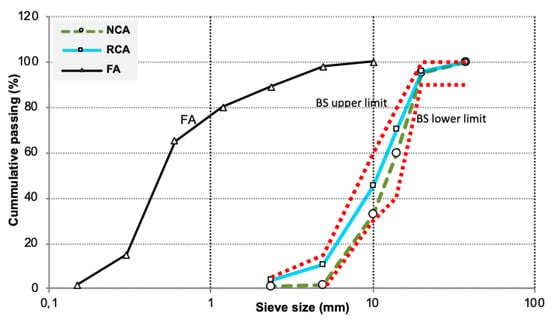
Figure 1.
Gradation of natural and recycled aggregates used. NCA: Natural coarse aggregates; RCA: recycled concrete coarse aggregates; FA: sand.
2.2. Concrete Proportioning
All concrete mixes studied were proportioned using the BRE mix design method or what is formerly named as DoE method. The characteristic strength or the concrete grade was first specified to meet the three strength classes chosen for this study and then determining the proportions of each concrete components as specified in the mix design BRE method.
RCA-concrete mixes were proportioned with a replacement level of 30, 50 and 100% of the NCA by the RCA. The concrete mix design for 1 m3 is given in Table 2. The mix proportioning approach targeted three concrete classes C15, C20 and C30 corresponding to an average 28 days’ characteristic cube compressive strength of 15, 20 and 30 MPa, respectively. Concrete mixes are labelled as follows: C12/15, C16/20, and C25/30, which refers to the concrete minimum cube compressive strength grades of 15, 20, and 30 MPa at 28 days, respectively. As the substitution level of NCA by the RCA increases, the w/c ratio of concrete was reduced to compensate for the strength loss induced by the incorporation of the RCA into the concrete mix. Concrete mixtures were prepared in a horizontal pan-type laboratory mixer of 0.05 m3 capacity, and fresh concrete properties were determined immediately after mixing. The fresh properties of concrete determined consist of the slump value as per BS 1881-102:1983 [34] and the compacting factor as per BS 1881-103:1993 [35].

Table 2.
Batching weight for 1 cubic meter of concrete with and without RCA.
2.3. Concrete Sampling
All concrete specimens were cast and consolidated using a standard vibrating table as per BS 1881-125: 1986 [36] and BS 1881-108: 1983 [37], covered with plastic foil and kept in the laboratory environment at 20 ± 2 °C and 60 ± 5% of RH. Following the first 24 h after concrete casting, all specimens were demoulded and cured underwater at 20 ± 2 °C and 100% of RH till 28 days.
2.4. Testing Procedures
For this study, two curing systems were selected. Water curing at 20 ± 2 °C for 28 days and a dry air curing under 60 ± 5% of RH at 20 ± 2 °C depending on the specific testing procedure.
Compressive, tensile splitting and flexural strengths were measured at the ages of 3, 7, 14, and 28 days on water-cured cubic specimens of 100 mm, cylinders of 150 × 300 mm and prisms measuring 100 × 100 × 500 mm in accordance with EN 12390-3:2002 [38], BS 1881-117:1983 [39] and BS 1881-118: 1983 [40], respectively. Modulus of elasticity was measured on water-cured cylinders of 150 × 300 mm at the ages of 3, 7, 14, and 28 days as per BS1881-121:1983 [41] and BS EN 12390-13:2013 [38].
The initial surface absorption (ISA) was determined on cubic specimens of 150 mm water-cured for 28 days as per BS 1881-208:1996 [42]. Sulphate attack resistance of concrete was assessed following the specification of BS 4027:1996 [43]. The testing was conducted by immersing concrete prisms in a solution with 0.3g/l of Na2SO4 for a period of 4 weeks and length change was periodically recorded. Chloride ingress was conducted on cubes immersed in a solution of 1 mol of NaCl as per BS EN 12390-11:2015 [44]. The accelerated carbonation test was done on 100-mm cubes where all sides of the specimen were coated, except the specimen top side, which was exposed to 3.5% of CO2 and stored in a carbonation chamber. Concrete carbonation depth was determined on the surface of fragmented freshly broken pieces of the specimens after different periods of 2, 4, 8, 12, and 20 weeks of exposure in the carbonation chamber. The test was conducted as per BS 1881-210:2013 [45].
3. Results and Discussion
3.1. Workability
For this study, the level of workability targeted was to reach a slump value of around 70 ± 20 mm and a compacting factor ranging between 0.94 and 0.97. For all concrete tested, the slump results were within the limits set and it was varying from 40 to 80 mm, while the compacting factor reached up to 0.98. These values are within the limits of slump classes S1 and S2, which are indicated in the EN 206–1:2000 [27] for the selected concrete grades. Because of the high porosity, water absorption and existing moisture in the RCA added to the mix, it was observed that increasing the amount of RCA has generally slightly increased the slump value. It is believed that the existing RCA initial moisture may lead to the initial slump enhancement of the RCA-concrete mixes compared with their corresponding NCA-concrete. Also, the reduction in the w/c ratio of the RCA-concrete to reach the target slump slightly affected the workability of concrete, but remains within the tolerance specified as for the two slump classes S1 and S2. Overall, RCA added at different contents as a partial substitution of NCA did not have any negative impact on the workability of concrete but even improved the initial slump.
3.2. Mechanical Performances
3.2.1. Compressive Strength Development
The compressive strength results are shown in Figure 2, Figure 3 and Figure 4. For all RCA-concretes, the targeted design strength was achieved. Although the overall compressive strength trend shows a decrease when the replacement ratio of NCA by the RCA increases, this trend seems to be affected by the concrete design strength and its w/c ratio. The C12/15, and especially C16/20, show no significant differences between mixes with RCA content, which is an indicator of the possibility to design a RCA-concrete with similar compressive strength to the NCA-concrete by reducing its w/c ratio. The compressive strength of low grade concrete (C12/15 and C16/20) seems to be less affected by the type and quality of the coarse aggregate used, because at this level of strength, even low quality aggregate might be able to support the applied load. The C25/30, however, shows an important strength drop for the concrete made with 100% RCA compared to 30% and 50% replacement ratios. This discrepancy in the RCA-concrete could be attributed to the RCA intrinsic properties, which greatly affect the concrete performances. The thickness, quality characteristics, and strength of the original mortar adhered on the RCA is one of the key parameters influencing the new concrete properties as reported in several previous research works [46,47,48]. The fact that the residual adhering old mortar on the RCA is the main cause of strength reduction is evidenced by observing the failure planes that occurred around the RCA, indicating that the paste-RCA interracial transition zone is the limiting strength parameter. The results also indicate that low strength concrete is less sensitive to the replacement of NCA by the RCA as compared to normal strength concrete. In fact, low strength concrete takes most of its strength from the aggregate skeleton as the strength of the cement paste is weak due to the high w/c ratio. Although the RCA are weaker than the NCA because of the mortar layer adhered on the original aggregate, the latest could contribute to ensure the minimum strength design for this grade C12/15. It is worth to mention that this concrete grade C12/15 has limited uses for non-structural concrete such as backfill, road bases, walkway and other applications where durability considerations under specified exposure conditions do not allow such a high w/c ratio. Overall, adding up to 30% of RCA was found to be the optimum amount, while beyond this ratio, a drop in the compressive strength was recorded.
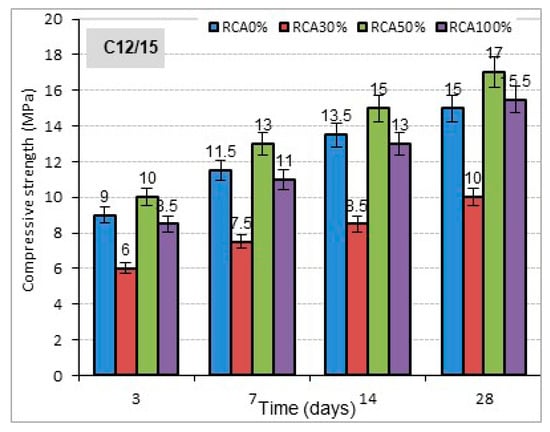
Figure 2.
Compressive strength development for C12/15 concretes with various proportions of RCA.
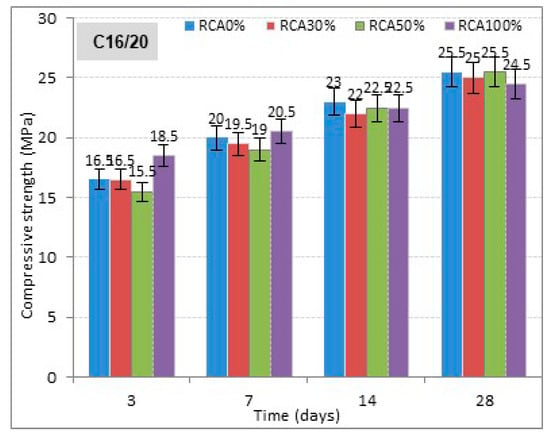
Figure 3.
Compressive strength development for C16/20 concretes with various proportions of RCA.
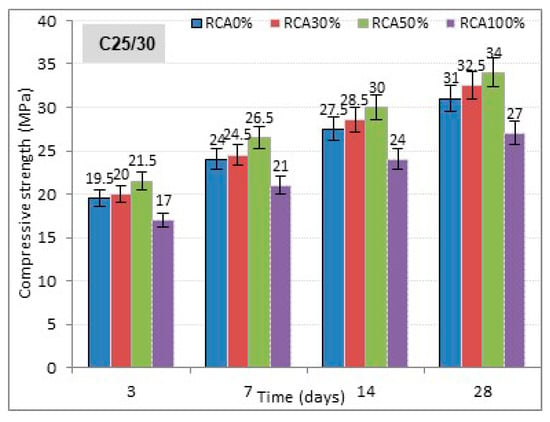
Figure 4.
Compressive strength development for C25/30 concretes with various proportions of RCA.
3.2.2. Modulus of Elasticity
The modulus of elasticity results for the three concrete grades are shown in Figure 5, Figure 6 and Figure 7. Similar to the compressive strength behaviour, the RCA content significantly affects the concrete’s elastic modulus. The results indicate a quite proportional decrease in the elastic modulus as the RCA content in the concrete increases. Modulus of elasticity of low and normal strength concretes is recognized to be greatly influenced by the porosity of the concrete mix and the aggregate fraction, especially the coarse aggregate portion, and is less affected by the cement paste matrix as reported by some authors [49,50]. As the aggregate’s porosity increases, the elastic modulus of the RCA-concrete decreases.
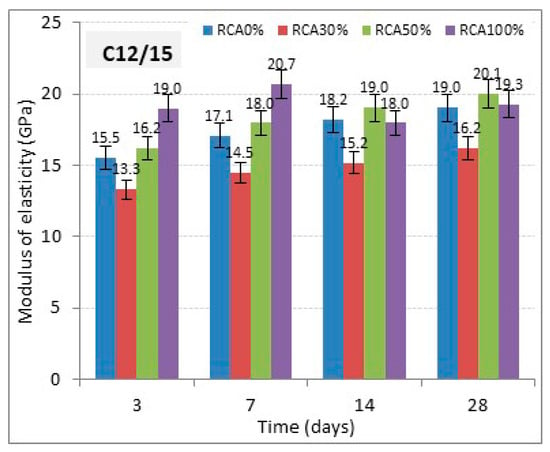
Figure 5.
Effect of proportions of RCA on the modulus of elasticity development for C12/15 concretes.
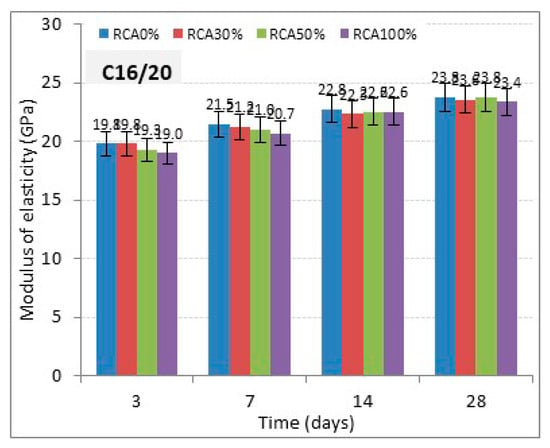
Figure 6.
Effect of proportions of RCA on the modulus of elasticity development for C16/20 concretes.
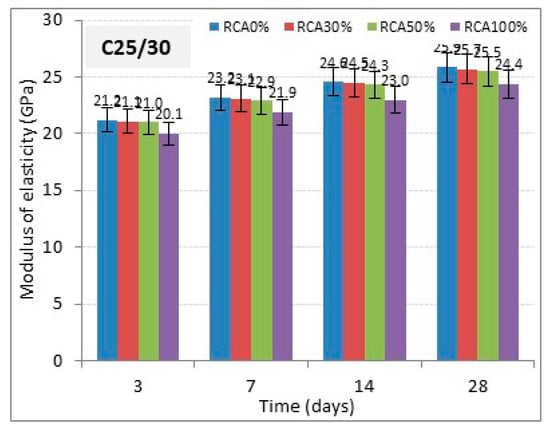
Figure 7.
Effect of proportions of RCA on the modulus of elasticity development for C25/30 concretes.
Previous research concluded that the elastic modulus of RCA-concrete is approximately 15% to 30% lesser than the modulus of elasticity of normal concrete [51,52], while Gholampour et al. [53] found that the elastic modulus decreases generally by about 20% when the replacement level is increasing. The literature survey indicated a large agreement of an imminent drop in the mechanical characteristics of RCA-concrete, and this drop is higher with the increase of the replacement level of NCA by the RCA. Many key factors contributing to this reduction in the mechanical performances are largely linked to the quality of the old residual mortar adhering to the aggregates. These factors were reported by other scholars [47,54,55,56] whom also attributed the reduction in the elastic modulus of RCA-concrete to the high percentages of voids and microcracks of the old layer of mortar that adhered to the RCA.
3.2.3. Flexural strength
The results of flexural strength are displayed in Figure 8, Figure 9 and Figure 10. Independently of the type of aggregates used, the flexural strength increases when increasing the concrete grade and reducing its w/c ratio.
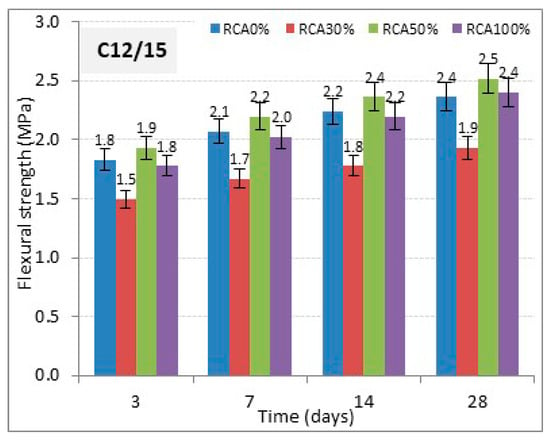
Figure 8.
Effect of RCA content on the flexural strength development for C12/15 concretes.
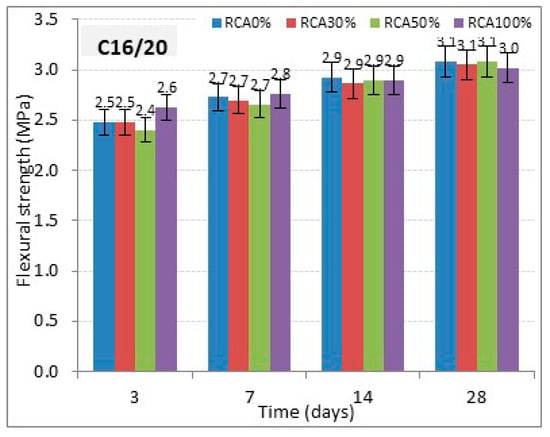
Figure 9.
Effect of RCA content on the flexural strength development for C16/20 concretes.
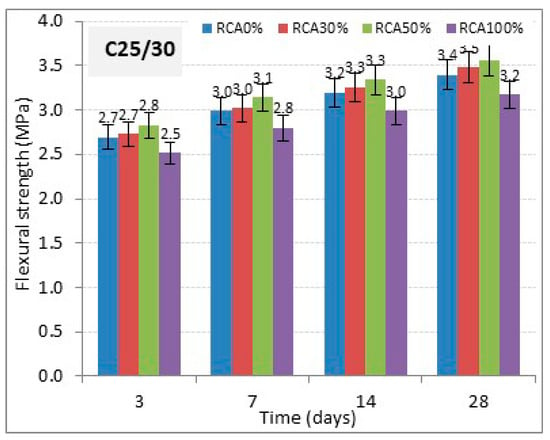
Figure 10.
Effect of RCA content on the flexural strength development for C25/30 concretes.
Overall, the flexural strength ranged from 1.8 to 3.5 MPa, depending on the concrete grade and the percentage of RCA incorporated in the concrete. The usage of RCA in a partial/full replacement of NCA has led, generally, to a decrease in the flexural strength of concrete. Similar to the compressive, splitting tensile strengths and modulus of elasticity, some discrepancy of the results could be identified due to the large variations in the source and quality of the used RCA.
The flexural strength reduction of the RCA-concrete is attributable to the weakness in the bonding strength, linking the aggregate fraction and the cement paste. The weakness of this interfacial transition zone (ITZ) is strongly linked to the RCA characteristics. The porous and inferior strength of the old mortar that adhered on the RCA contribute greatly to the weakness of this bonding strength between the aggregate skeleton and the cement paste, as also reported by Pareek K et al. [57]. The higher the proportion of the RCA added to the mix, the larger the surface area developed by the RCA, and hence, the weaker the bonding and the flexural strengths of the RCA-concrete. In fact, this reduction in the flexural strength with increasing RCA content was also reported by Lakshami and Nivedhitha [58]. Although the usage of RCA to replace all or part of the natural aggregate could result in a reduction in the flexural strength, researchers have found that concrete beams with RCA have generated larger mid-span deflections with respect to the concrete beams made with solely NCA. This increase in the mid-span deflections was attributed to the lower elastic modulus of the RCA-concrete compared to the NCA-concrete [59].
3.2.4. Splitting Tensile Strength
The split tensile strength results for the three concrete grades are shown in Figure 11, Figure 12 and Figure 13. Generally, the substitution of NCA by the RCA has reduced the tensile splitting strength. This reduction was more appreciable for low strength concrete and full replacement of the NCA by the RCA. However, increasing the concrete grade and reducing its w/c ratio has minimized the tensile strength drop as shown in Figure 9 for the C25/30 concrete grade. Concrete made with virgin natural materials is known for its brittleness and weakness to support tension loads. Substituting part or all the virgin aggregate with a recycled one leads to further weakness, especially in the bonding strength. Indeed, the substitution of NCA by the RCA weakens the interfacial transition zone between the aggregate fraction and the cement matrix due to the presence of attached old mortar remaining on the surface of the original aggregate, which reduces its tensile strength as also reported in previous researches [47,48,57].
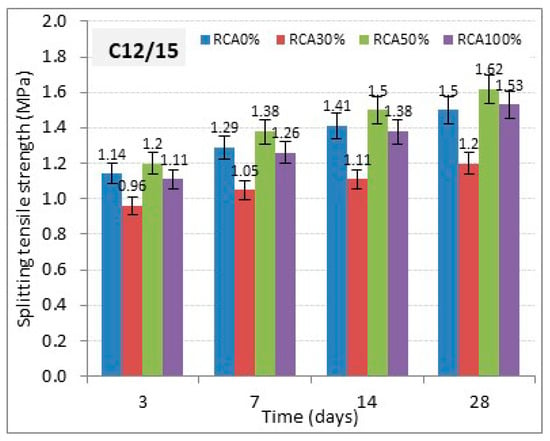
Figure 11.
Effect of RCA content on the splitting tensile strength development for C12/15 concretes.
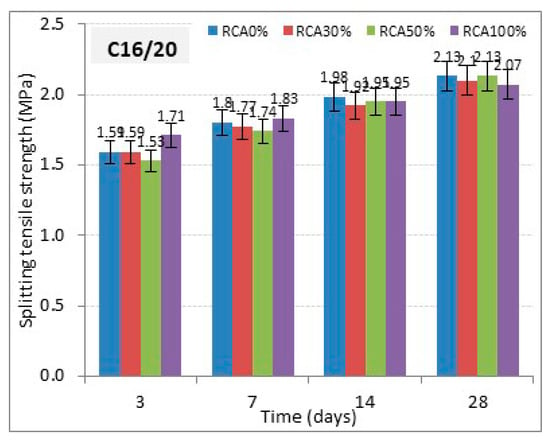
Figure 12.
Effect of RCA content on the splitting tensile strength development for C16/20 concretes.
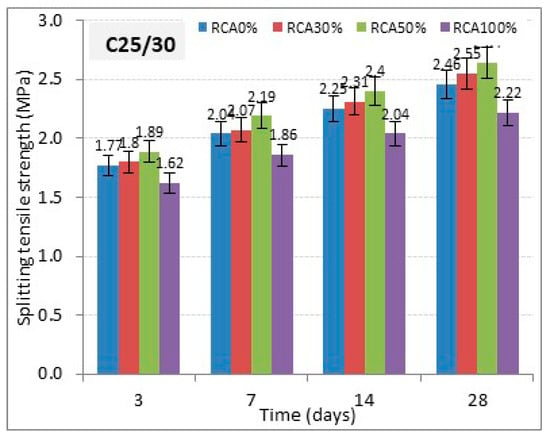
Figure 13.
Effect of RCA content on the splitting tensile strength development for C25/30 concretes.
3.3. Durability Performances
The durability of concrete produced using the RCA was examined in terms of porosity, resistance to carbonation, chloride ingress, and sulphate attack. The effect of partially or fully substituting NCA with the RCA was studied.
3.3.1. Porosity
The ISA-10 test results of the control and RCA-concretes designed with various RCA contents are presented in Figure 14. Embedding various amounts of RCA as part or even full substitution of NCA increased the ISA-10 as could be seen in Figure 10. The higher the substitution ratio of the RCA, the higher the ISA-10 of the concrete. The increase in ISA-10 was more noticeable for C12/15 as compared to C16/20 and C25/30. For the three grades of concrete investigated, using 30% RCA showed no significant increase in the ISA-10, while beyond this content, the ISA-10 increased rapidly. The increase in the ISA-10 of the RCA-concrete is due to the highly porous and absorptive nature of the RCA used.
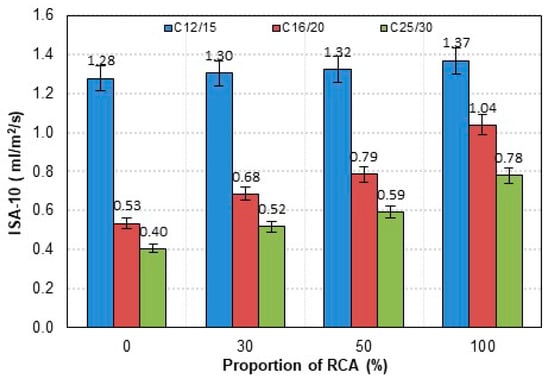
Figure 14.
Effect of RCA proportions in the mix on the ISA-10 of concrete.
3.3.2. Carbonation Resistance
The process of concrete carbonation involves the formation of calcite (CaCO3) as a result of the reaction between the calcium hydroxide (Ca(OH)2) from cement hydration and carbon dioxide (CO2). Figure 15 and Figure 16 display the results of carbonation depth for C16/20 and C25/30 concretes. The carbonation depth is proportionate to the CO2 concentration and time of exposure. The higher the exposure time, the higher the carbonation depth. Increasing the RCA content in the concrete has, generally, led to lower carbonation resistance for the C30 grade, while the carbonation depth of the C20 concretes was slightly affected. In low-grade concrete strength C20, the carbonation is fast as carbon dioxide can infiltrate the concrete more easily while for higher-grade concrete strength such as C30, the carbonation rate and depth evolve slowly.
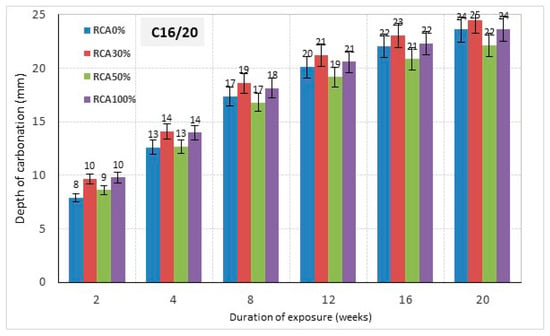
Figure 15.
Depth of carbonation versus the exposure duration of C16/20 concretes.
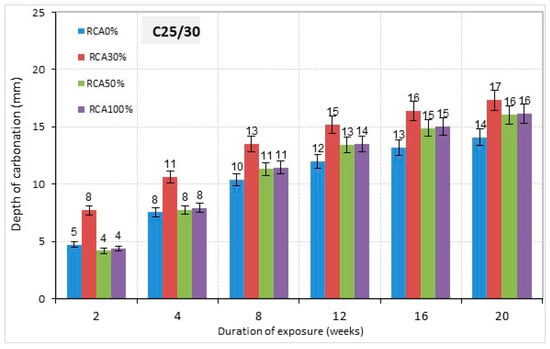
Figure 16.
Depth of carbonation versus the exposure duration of C25/30 concretes.
3.3.3. Sulphate Resistance
The swelling strains induced by sulphate solution were measured up to 28 days’ immersion, and the results are displayed in Figure 17 and Figure 18. It was found that increasing the curing age and the RCA content in the mix increases the swelling strains magnitude. Overall, sulphate attack mechanism includes the formation of ettringite and gypsum, which expands concrete and induces internal tension that may lead to macro and microcracks in the hardened concrete. As a result of the sulphate attack, incorporating 30% to 50% of RCA showed only a slight swelling while 100% replacement of NCA by the RCA has led to a significant increase of the swelling by around 25 με to reach a total of 74 με and 88 με at 28 days compared with 49 με and 54 με for the control concrete for the C16/20 and C12/15, respectively. For both concrete grades, the full replacement of NCA by the RCA seems to contribute to the increase of the expansion and degrading the concrete’ sulphate resistance.
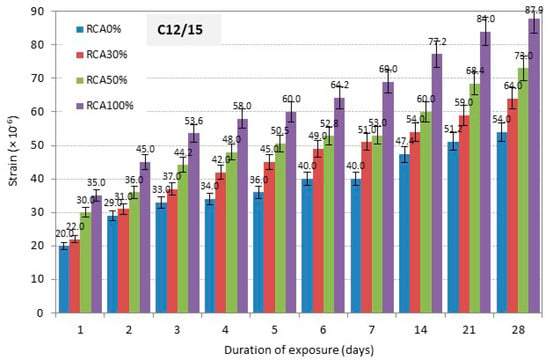
Figure 17.
Effect of RCA content on the expansion due to sulphate attack for the C12/15 concretes.
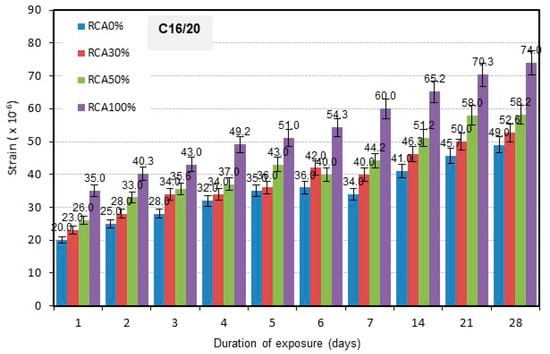
Figure 18.
Effect of RCA content on the expansion due to sulphate attack for the C16/20 concretes.
3.3.4. Chloride Permeation
Chloride ingress refers to the extent to which chloride ions from the surrounding environment could enter and infiltrate into the hardened solid concrete material. The chloride penetration is, of course, highly considered when the concrete structural element is reinforced with steel rebar that could corrode and lead to cracks and fall in the load-carrying capacity of the reinforced concrete structure.
The chloride ingress results of the concrete grade C25/30 are presented in Figure 19 for the RCA-concrete as well as the control concrete. The concentration of chloride is always high near to the surface exposed and it decreases beyond the surface for all concretes examined. It is well known that chloride penetration is strongly related to the w/c ratio, concrete strength, porosity, and the substitution level of NCA by the RCA. The higher the amount of RCA in the concrete, the higher the chloride concentration, especially in the exposed surface as also reported by other researchers [60]. Indeed, the high porosity and low compressive strength of RCA-concrete contributes to this high chloride concentration. The chloride ions from the medium that concrete is exposed to penetrate into the mass of the concrete through the capillary pores and cracks. These two parameters are likely to occur more in concrete with the RCA than NCA. The presence of RCA in the concrete increases the volume and the thickness of the old layer of mortar that adhered to the original aggregates and hence, rises in the total pore volume of the concrete, which gives way for the chloride ions to penetrate into the concrete. This was also reported in previous studies [47] where chloride penetration was attributable to the volume of pores in the attached old mortar on the original aggregate. Also, this volume increase in the old mortar adhered to aggregate increases drying shrinkage and the interfacial transition zone, which leads to an easier and higher chloride penetration, especially in case of full replacement of NCA by the RCA as demonstrated in Figure 19.
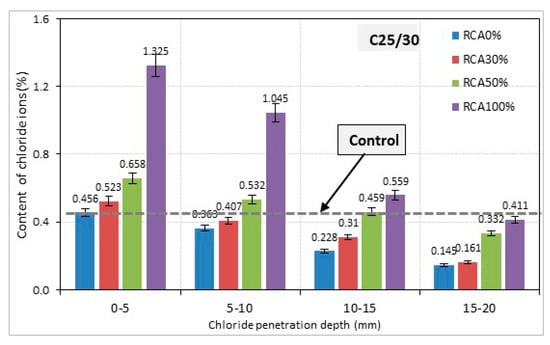
Figure 19.
Chloride content versus chloride penetration depth for the C25/30 concrete strength class.
The overall results of the mechanical and durability study using RCA in low and normal strengths concrete has revealed a great potential to incorporate RCA in non-structural concrete as well as in structural concrete. Additional mechanical and thermal treatment, as proposed in many recent studies, of the RCA to remove or at least reduce the thickness of the layer of the old mortar adhered on the aggregate could enhance the RCA performances. Indeed, removing or reducing the thickness of adhered mortar requires more processing and consumes higher energy, which raises the final product cost and may dissuade the end-users to opt for recycled aggregates instead of natural ones. However, the numerous environmental benefits of using recycled aggregates generated from the debris of old and demolished concrete structures are the major incentive to promote and publicize their use in the concrete industry.
4. Summary and Conclusive Remarks
Based on the results of the mechanical and durability study, the following conclusions can be drawn:
- It was found that RCA derived from waste debris of construction demolition can be used as a secondary aggregate in concrete. Overall, their physical and mechanical characteristics are acceptable and within the requirements limits of BS-related Standard test methods. The RCA characterization indicates a lower density and unit weight, as well as a higher crushing value and water absorption with respect to the natural aggregate.
- A series of low and normal strength concretes were designed using RCA as a partial and full substitution of the natural coarse aggregate. By adjusting the w/c ratio, the target design strength was achieved for all concretes including mixes with a full substitution of NCA by the RCA.
- Although a slight increase in the initial slump values of the RCA-concrete was observed, the overall usage of RCA did not significantly affect the workability of RCA-concrete.
- At the hardened state and overall, the incorporation of RCA into concrete has reduced the compressive, flexural and tensile splitting strengths, and the elastic modulus of the RCA-concrete. This reduction was proportional to the RCA content in the concrete.
- Although the RCA have lower quality with respect to the natural aggregates, the durability performances of concrete made with the RCA were not significantly deteriorated. A slight increase in the porosity of RCA-concrete was noticed, which led to an increase in the carbonation depth and the swelling generated by the sulphate attack. Total chloride ingress has also increased, especially for the concrete made with 100% RCA.
- It is concluded that using up to 30% of the RCA indicated no significant negative impact on the key mechanical and durability properties of the RCA-concretes, even some strength enhancement was observed up to 50% replacement ratio, especially for C25/30 concrete grade. However, durability performances including carbonation, sulphate, and chloride attack resistances decreased when increasing the RCA content beyond 30% replacement level.
- Finally, although RCA are for the most common practices used in low to normal strength concrete, RCA could also be employed to produce concrete having higher strength (30 MPa and more) and acceptable durability.
Author Contributions
M.S.M.: Conceptualization, methodology, validation, formal analysis, investigation, visualization, writing—original draft preparation, writing—review and editing; A.A.-H.: Conceptualization, visualization, writing—original draft preparation; M.A.I.: Formal analysis, validation, writing—review and editing. All authors have read and agreed to the published version of the manuscript.
Funding
This research received no external funding.
Conflicts of Interest
The authors declare no conflict of interest.
References
- Vivian, W.Y.; Tam, M.S.; Evangelista, A.C.J. A review of recycled aggregate in concrete applications (2000–2017). Constr. Build. Mater. 2018, 172, 272–292. [Google Scholar]
- Meddah, M.S. Recycled aggregates in concrete production: Engineering properties and environmental impact. MATEC Web Conf. 2017, 101, 5021. [Google Scholar] [CrossRef]
- Silva, R.V.; de Brito, J.; Dhir, R.K. Fresh-state performance of recycled aggregate concrete: A review. Constr. Build. Mater. 2018, 178, 19–31. [Google Scholar] [CrossRef]
- Hasaba, S.; Kawamura, M.; Toorii, K.; Takemoto, K. Drying shrinkage and durability of concrete made with recycled concrete aggregates. Trans. Jpn. Concr. Inst. 1981, 3, 55–60. [Google Scholar]
- Hansen, T.C.; Narud, H. Strength of recycled concrete made from crushed concrete coarse aggregate. Concr. Int. Des. Constr. 1983, 5, 79–83. [Google Scholar]
- Nixon, P.J. Recycled concrete as an aggregate for concrete—A review. Mater. Struct. RILEM 1977, 65, 371–378. [Google Scholar] [CrossRef]
- Huisman, C.L.; Briston, R.A. Recycled Portland cement concrete specifications and control, FHWA; Federal Highway Report FHWA-TS-82-208. In Proceedings of the National Seminar on PCC Pavement recycling and rehabilitation, St. Louis, MO, USA, 28–30 September 1982. [Google Scholar]
- Building Contractors Society of Japan. Study on recycled aggregate and recycled aggregate concrete, BCSJ, Committee on Disposal and Reuse of Concrete Construction Waste. Concr. J. 1978, 16, 18–31. [Google Scholar] [CrossRef]
- Ravindrarajah, R.S.; Tam, C.T. Properties of concrete made with crushed concrete as coarse aggregate. Mag. Concr. Res. 1985, 37, 29–38. [Google Scholar] [CrossRef]
- Mukai, T.; Kemi, T.; Nakagawa, M.; Kikuchi, M. Study on reuse of waste concrete for aggregate of concrete. In Proceedings of the Seminar on Energy and Resource Conservation in Concrete Technology, Japan-US Cooperative Science Programme, San Fransisco, CA, USA, 10–13 September 1979. [Google Scholar]
- Malhotra, V.M. Use of recycled concrete as a new aggregate. Report, No.76-8. In Proceedings of the Symposium on Energy and Resource Conservation in the Cement and Concrete Industry, CANMET, Ottawa, ON, Canada, 21–23 October 1978. [Google Scholar]
- Buck, A.D. Recycled concrete as a source of aggregate. ACI J. 1977, 74, 212–219. [Google Scholar]
- Abdelfattah, A.; Tabsh, S.W. Feasibility of using recycled concrete in the United Arab Emirates. In Proceedings of the ICPCM—A New Era of Building, Cairo, Egypt, 18–20 February 2003. [Google Scholar]
- Tang, W.; Khavarian, M.; Yousefi, A.; Cui, H. Properties of Self-Compacting Concrete with Recycled Concrete Aggregates. In Self-Compacting Concrete: Materials, Properties and Applications; Siddique, R., Ed.; Woodhead Publishing: Cambridge, UK, 2020; pp. 219–248. [Google Scholar]
- Ryu, J.S. An experimental study on the effect of recycled aggregate on concrete properties. Mag. Concr. Res. 2002, 54, 7–12. [Google Scholar] [CrossRef]
- Tang, W.; Khavarian, M.; Yousefi, A.; Chan, R.W.K.; Cui, H. Influence of Surface Treatment of Recycled Aggregates on Mechanical Properties and Bond Strength of Self-Compacting Concrete. Sustainability 2019, 11, 4182. [Google Scholar] [CrossRef]
- Pacheco, J.; de Brito, J.; Chastre, C.; Evangelista, L. Experimental investigation on the variability of the main mechanical properties of concrete produced with coarse recycled concrete aggregates. Constr. Build. Mater. 2019, 201, 110–120. [Google Scholar] [CrossRef]
- Chen, H.J.; Yen, T.; Chen, K.H. Use of building rubbles as recycled aggregates. Cem. Concr. Res. 2003, 33, 125–132. [Google Scholar] [CrossRef]
- Katz, A. Properties of concrete made with recycled aggregate from partially hydrated old concrete. Cem. Concr. Res. 2003, 33, 703–711. [Google Scholar] [CrossRef]
- Al-Harthy, A.S.; Taha, R.; Al-Saidy, A.; Al-Oraimi, S. Properties of recycled aggregate concrete. In Proceedings of the 2nd ACI-Kuwait Chapter Conference, Kuwait City, Kuwait, 12–15 March 2007. [Google Scholar]
- Mostafa, T.; Parviz, S. Strength of recycled aggregate concrete made using filed-demolished concrete as aggregate. ACI Mater. J. 1996, 93, 182–190. [Google Scholar]
- Buyle-Bodin, F.; Hadjieva-Zaharieva, R. Influence of industrially produced recycled aggregates on flow properties of concrete. Mater. Struct. 2002, 35, 504–509. [Google Scholar] [CrossRef]
- Leemann, A.; Loser, R. Carbonation resistance of recycled aggregate concrete. Constr. Build. Mater. 2019, 204, 335–341. [Google Scholar] [CrossRef]
- Zaharieva, R.; Buyle-Bodin, F.; Skoczylas, F.; Wirquin, E. Assessment of the surface permeation properties of recycled aggregate concrete. Cem. Concr. Compos. 2003, 25, 223–232. [Google Scholar] [CrossRef]
- Neves, R.; Silva, A.; De Brito, J.; Silva, R.V. Statistical modelling of the resistance to chloride penetration in concrete with recycled aggregates. Constr. Build. Mater. 2018, 182, 550–560. [Google Scholar] [CrossRef]
- European Aggregates Association/Union Européenne des Producteurs de Granulats (UEPG). Available online: http://www.uepg.eu/ (accessed on 25 August 2020).
- European Committee for Standardization (CEN). Concrete—Part 1: Specification, Performance, Production and Conformity; EN 206-1: 2000; CEN: Brussels, Belgium, 2000. [Google Scholar]
- British Standards Institution (BSI). Cement. Composition, Specification and Conformity Criteria for Common Cements; BS EN 197-1: 2011; BSI: London, UK, 2011. [Google Scholar]
- ASTM International. ASTM C150/C150M Standard Specification for Portland Cement; ASTM International: West Conshohocken, PA, USA, 2020; Available online: www.astm.org (accessed on 25 June 2020).
- British Standards Institution (BSI). Concrete—Complementary British Standard to BS EN 206 Part 2: Specification for Constituents Materials and Concrete (+A1:2012); BS 8500-2: 2015; BSI: London, UK, 2015. [Google Scholar]
- British Standards Institution (BSI). Tests for Geometrical Properties of Aggregates. Part 1: Determination of Particle Size Distribution; BS EN 933-12012; BSI: London, UK, 2012. [Google Scholar]
- British Standards Institution (BSI). Specification for Aggregates from Natural Sources for Concrete; BS 882:1992; BSI: London, UK, 1992. [Google Scholar]
- British Standards Institution (BSI). Aggregates for Concrete; BS EN 12620:2002+A1; BSI: London, UK, 2002. [Google Scholar]
- British Standards Institution (BSI). Testing Concrete—Part 102: Method for Determination of Slump; BS 1881-102:1983; BSI: London, UK, 1983. [Google Scholar]
- British Standards Institution (BSI). Testing Concrete—Part 103: Method for Determination of Compacting Factor; BS 1881-103:1993; BSI: London, UK, 1993. [Google Scholar]
- British Standards Institution (BSI). Testing Concrete—Part 125: Methods for Mixing and Sampling Fresh Concrete in the Laboratory; BS 1881-125: 1986; BSI: London, UK, 1986. [Google Scholar]
- British Standards Institution (BSI). Testing Concrete—Part 108: Method for Making Test Cubes from Fresh Concrete; BS 1881-108: 1983; BSI: London, UK, 1983. [Google Scholar]
- British Standards Institution (BSI). Testing Hardened Concrete. Compressive Strength of Test Specimens; BS EN 12390-3:2002; BSI: London, UK, 2002. [Google Scholar]
- British Standards Institution (BSI). Testing Concrete—Part 103: Method for Determination of Tensile Splitting Strength; BS 1881-117: 1983; BSI: London, UK, 1983. [Google Scholar]
- British Standards Institution (BSI). Testing Concrete—Part 103: Method for Determination of Flexural Strength; BS 1881-118: 1983; BSI: London, UK, 1983. [Google Scholar]
- British Standards Institution (BSI). Testing Concrete. Method for Determination of Static Modulus of Elasticity in Compression; BS 1881-121:1983; BSI: London, UK, 1983. [Google Scholar]
- British Standards Institution (BSI). Testing Concrete. Recommendations for the Determination of the Initial Surface Absorption of Concrete; BS 1881-208:1996; BSI: London, UK, 1996. [Google Scholar]
- British Standards Institution (BSI). Specification for Sulfate-Resisting Portland Cement; BS 4027:1996; BSI: London, UK, 1996. [Google Scholar]
- British Standards Institution (BSI). Testing Hardened Concrete. Determination of the Chloride Resistance of Concrete, Unidirectional Diffusion; BS EN 12390-11:2015; BSI: London, UK, 2015. [Google Scholar]
- British Standards Institution (BSI). Testing Hardened Concrete. Determination of the Potential Carbonation Resistance of Concrete. Accelerated Carbonation Method; BS 1881-210:2013; BSI: London, UK, 2013. [Google Scholar]
- Zheng, C.; Lou, C.; Du, G.; Li, X.; Liu, Z.; Li, L. Mechanical properties of recycled concrete with demolished waste concrete aggregate and clay brick aggregate. Results Phys. 2018, 9, 1317–1322. [Google Scholar] [CrossRef]
- Bhasya, V.; Bharatkumar, B.H. Mechanical and Durability Properties of Concrete Produced with Treated Recycled Concrete Aggregate. ACI Mater. J. 2018, 115, 209–217. [Google Scholar] [CrossRef]
- Assaad, J.J.; Matar, P.; Gergess, A. Effect of quality of recycled aggregates on bond strength between concrete and embedded steel reinforcement. J. Sustain. Cem. Based Mater. 2020, 9, 94–111. [Google Scholar] [CrossRef]
- Khatib, J.M.; Herki, B.A.; Elkordi, A. Use of Recycled Plastics in Eco-Efficient Concrete; Series in Civil and Structural Engineering; Woodhead Publishing: Cambridge, UK, 2019; pp. 137–165. [Google Scholar]
- Meddah, M.S.; Zitouni, S.; Belâabes, S. Effect of content and particle size distribution of coarse aggregate on the compressive strength of concrete. Constr. Build. Mater. 2010, 24, 505–512. [Google Scholar] [CrossRef]
- Pedro, D.; de Brito, J.; Evangelista, L. Structural concrete with simultaneous incorporation of fine and coarse recycled concrete aggregates: Mechanical, durability and long-term properties. Constr. Build. Mater. 2017, 154, 294–309. [Google Scholar] [CrossRef]
- Madrigal, D.P.; Iannone, A.; Martìnez, A.H.; Giustozzi, F. Effect of Mixing Time and Temperature on Cracking Resistance of Bituminous Mixtures Containing Reclaimed Asphalt Pavement Material. J. Mater. Civ. Eng. 2017, 29, 4017058. [Google Scholar] [CrossRef]
- Gholampour, A.; Gandomi, A.H.; Ozbakkaloglu, T. New formulations for mechanical properties of recycled aggregate concrete using gene expression programming. Constr. Build. Mater. 2017, 130, 122–145. [Google Scholar] [CrossRef]
- Ismail, S.; Kwan, W.H.; Ramli, M. Mechanical strength and durability properties of concrete containing treated recycled concrete aggregates under different curing conditions. Constr. Build. Mater. 2017, 155, 296–306. [Google Scholar] [CrossRef]
- Yaghoubi, E.; Arulrajah, A.; Wong, Y.C.; Horpibulsuk, S. Stiffness Properties of Recycled Concrete Aggregate with Polyethylene Plastic Granules in Unbound Pavement Applications. J. Mater. Civ. Eng. 2017, 29, 4016271. [Google Scholar] [CrossRef]
- Fan, Y.; Xiao, J.; Tam, V.W. Effect of old attached mortar on the creep of recycled aggregate concrete. Struct. Concr. 2014, 15, 169–178. [Google Scholar] [CrossRef]
- Pareek, K.; Saha, S.; Gupta, N.; Saha, P. Effect of Recycled Aggregate on Mechanical and Durability Properties of Concrete. Int. J. Struct. Civ. Eng. Res. 2019, 8, 109–125. [Google Scholar] [CrossRef]
- Lakshmi, S.M.; Nivedhitha, R.R. Effect of Partial Replacement of Aggregates by Recycled Concrete Debris on Strength of Concrete. Malays. J. Civ. Eng. 2015, 27, 250–259. [Google Scholar]
- Hamad, B.; Dawi, A.H.; Daou, A.; Chehab, G.R. Studies of the effect of recycled aggregates on flexural, shear, and bond splitting beam structural behavior. Case Stud. Constr. Mater. 2018, 9, 186. [Google Scholar] [CrossRef]
- Otsuki, N.; Miyazato, S.I.; Yodsudjai, W. Influence of Recycled Aggregate on Interfacial Transition Zone, Strength, Chloride Penetration and Carbonation of Concrete. J. Mater. Civ. Eng. 2003, 15, 443–451. [Google Scholar] [CrossRef]
© 2020 by the authors. Licensee MDPI, Basel, Switzerland. This article is an open access article distributed under the terms and conditions of the Creative Commons Attribution (CC BY) license (http://creativecommons.org/licenses/by/4.0/).